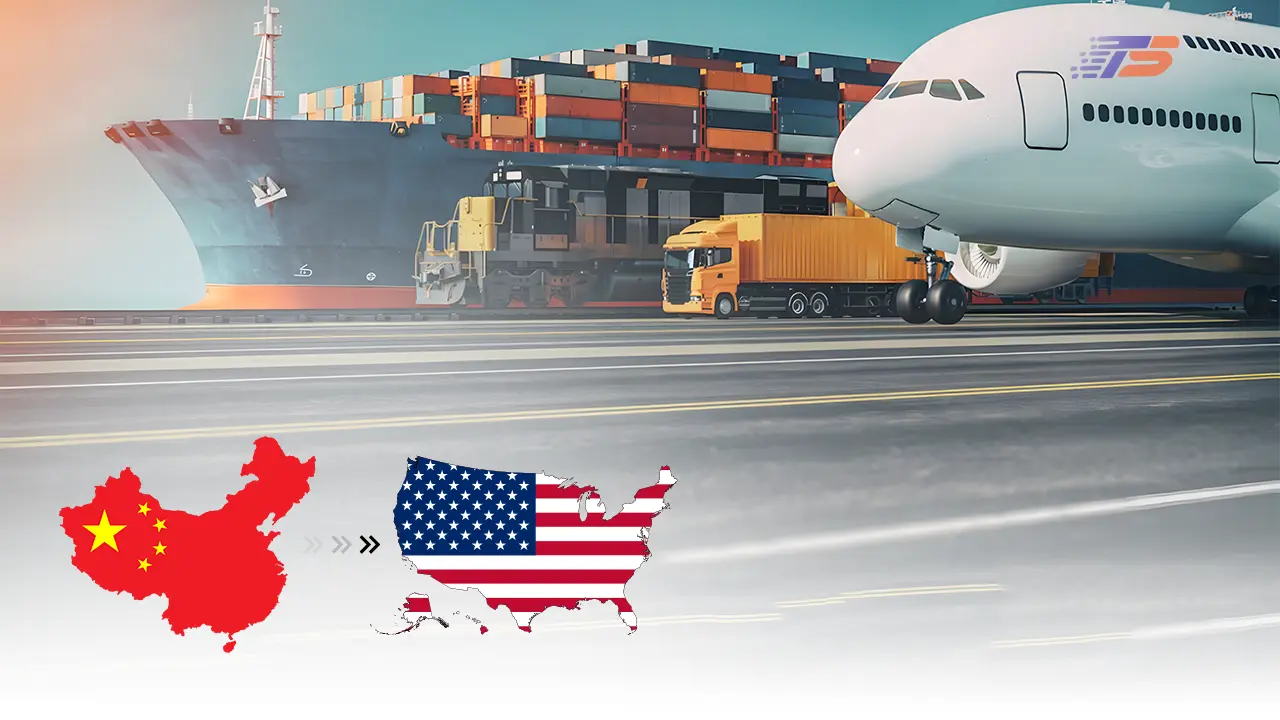With US container imports reaching 28.2 million TEU in 2024 – a 13% surge – shipping from China to US is more competitive than ever. Costs vary by shipping method, cargo size, and delivery speed, reflecting strong demand despite market fluctuations. Understanding these factors is essential to balance budget and timelines. This guide highlights key shipping routes and their effects on cost and delivery, helping businesses select the most efficient strategy for 2025.
Shipping from China to US: Latest Cost & Delivery Time (Aug 2025)
Average market rates and typical transit times for shipping from China to the US (as of August 2025):
Costs
- Air freight (100kg+ to major cities): ~$6.50/kg
- Sea freight (20′ container to West Coast): $1,800-$3,000
- Sea freight (20′ container to East Coast): $2,300-$3,400
- Sea freight (40′ container to West Coast): $2,500-$4,200
- Sea freight (40′ container to East Coast): $3,400-$5,500
Delivery Times
| Mode | Route | Cost | Transit Time |
| Air Freight | China → Major US Cities | ~$6.50/kg (100kg+) | 3-7 days |
| Express Shipping | China → US (Door-to-Door) | $8–15/kg | 1-5 days |
| Sea Freight | China → West Coast Ports | $1,800 (20′) · $2,500 (40′) | 15-25 days |
| Sea Freight | China → East Coast Ports | $2,300 (20′) · $3,400 (40′) | 25-35 days |
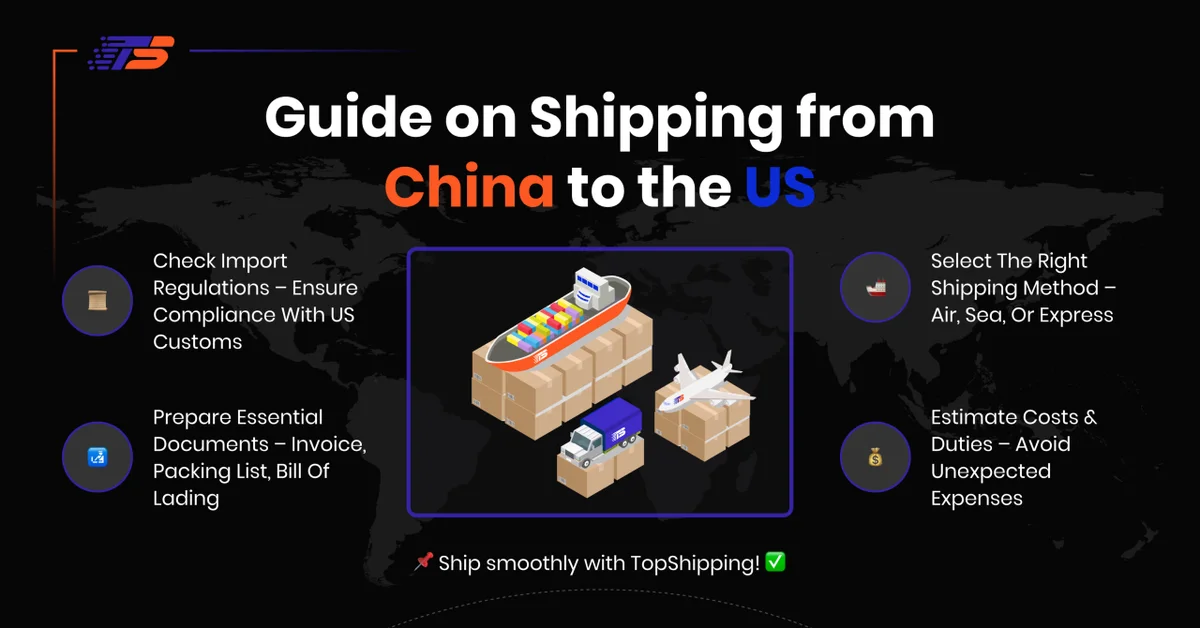
Air vs Sea vs Express: Choosing the Right China-US Shipping Method
The right shipping method from China to the USA can make or break your supply chain. Whether speed, predictability, or cost efficiency is your priority, express, air, and sea freight offer practical options suited to importers’ needs. For more educational resources on international shipping, visit the World Shipping Council. Here’s a quick overview of the methods:
| Method | Transit Time | Best For |
| Express Courier | 2-5 business days | Urgent samples, small parcels, high-value goods |
| Air Freight | 5-10 business days | Medium-sized shipments, time-sensitive orders, Amazon restocking |
| Ocean Freight (LCL) | 25-35 days | Smaller loads that don’t fill a container |
| Ocean Freight (FCL) | 25-35 days | Large-volume shipments, bulk imports |
| Door-to-Door Shipping | Varies by method (Air: ~7-12 days / Sea: ~30-40 days) | Importers seeking a single solution with minimal effort |
| Amazon FBA Shipping | 5-35 days (by Air or Sea) | E-commerce sellers replenishing US FBA warehouses |
Efficient Door-to-Door US Delivery
Delays or mishandled shipments can disrupt supply chains and slow business growth. Door-to-Door Shipping from China to US addresses these challenges by picking up goods directly from suppliers, handling export documentation in China, transporting them via Express, Air, or Sea, clearing US customs, and delivering straight to your warehouse or fulfillment center.
Whether importing product samples, high-value parcels, or full container loads, this method reduces touchpoints, prevents port bottlenecks, and keeps operations running smoothly allowing importers to match speed, reliability, and cost to their business priorities.
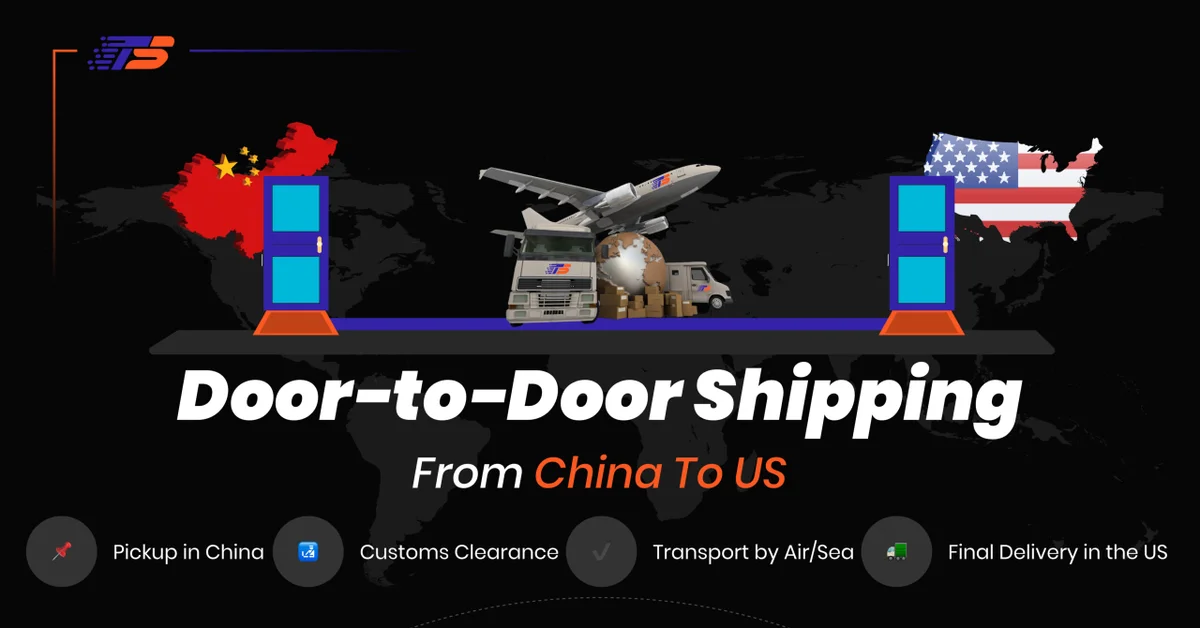
Amazon FBA Shipping Solutions: China-US
For e-commerce sellers, Amazon FBA shipping includes specialized services such as prep, labeling, and compliance checks, ensuring your products meet Amazon’s standards and reducing the risk of rejection. We simplify the process by handling the entire journey, allowing B2B importers and online sellers to focus on growing their business while shipments arrive reliably and on time.
Automated Order Fulfillment & Inventory Management
TopShipping’s automated system keeps all customer orders synchronized in real time, ensuring accurate inventory tracking, fast order processing, and seamless fulfillment from packing to delivery. For Amazon FBA sellers, this means timely inventory replenishment, fewer errors, and full visibility across the supply chain. Businesses can focus on growth and sales without worrying about day-to-day order management and shipping.
Container Types for Ocean Freight
Standard dry containers are ideal for general cargo, offering secure, cost-effective transport for most bulk goods. Refrigerated containers (reefers) maintain precise temperatures for perishable or sensitive products, ensuring quality on arrival. High cube containers provide extra height for oversized items or high-volume shipments without increasing costs. Here are the most common options for container shipping from china to us:
| Container Type | Internal Dimensions (L × W × H) | Max Volume (CBM) | Best Use Case |
| 20 ft Standard (TEU) | 5.9 m × 2.35 m × 2.39 m | 33-37 | Smaller shipments or heavy cargo (machinery, tiles, metals) |
| 40 ft Standard (FEU) | 12.03 m × 2.35 m × 2.39 m | 67-76 | Large-volume cargo without extra height (electronics, packaged goods) |
| 40 ft High Cube (HC) | 12.03 m × 2.35 m × 2.69 m | 76-86 | Light, bulky items (textiles, furniture, packaging foam) |
| LCL (Less than Container Load) | Shared container space | 1-25 | Cost-effective for SMEs, irregular shipments, or samples |
Pallets vs. Containers
For bulk shipments, we offer palletized cargo goods placed on pallets for efficient handling and transport, complementing standard containers.
China to US Transit Times: Air, Sea & Express
how long does shipping from China to US take? Shipping time from China to US varies by method and urgency. For importers, understanding transit times helps plan inventory, minimize delays, and keep operations running smoothly. Here’s a detailed breakdown:
| Shipping Method | Transit Time (Port/Airport to Port/Airport) | Customs Clearance & Handling | Total Estimated Delivery Time (Door-to-Door) | Best Suited For |
| Express Courier | 1-3 days | 1-2 days | 2-5 days | Urgent small packages, samples, documents |
| Air Freight | 3-6 days | 2-4 days | 5-10 days | Time-sensitive goods, medium volumes |
| Ocean Freight (LCL) | 15-25 days | 3-7 days | 18-32 days | Small to medium cargo, mixed shipments |
| Ocean Freight (FCL) | 12-22 days | 3-6 days | 15-28 days | Large volumes, full container loads |
| Door-to-Door Shipping | 8-15 days | Included in service | 8-15 days | Complete logistics solution, hassle-free |
| Amazon FBA Shipping | 10-20 days | 2-5 days | 12-25 days | E-commerce sellers, Amazon warehouses |
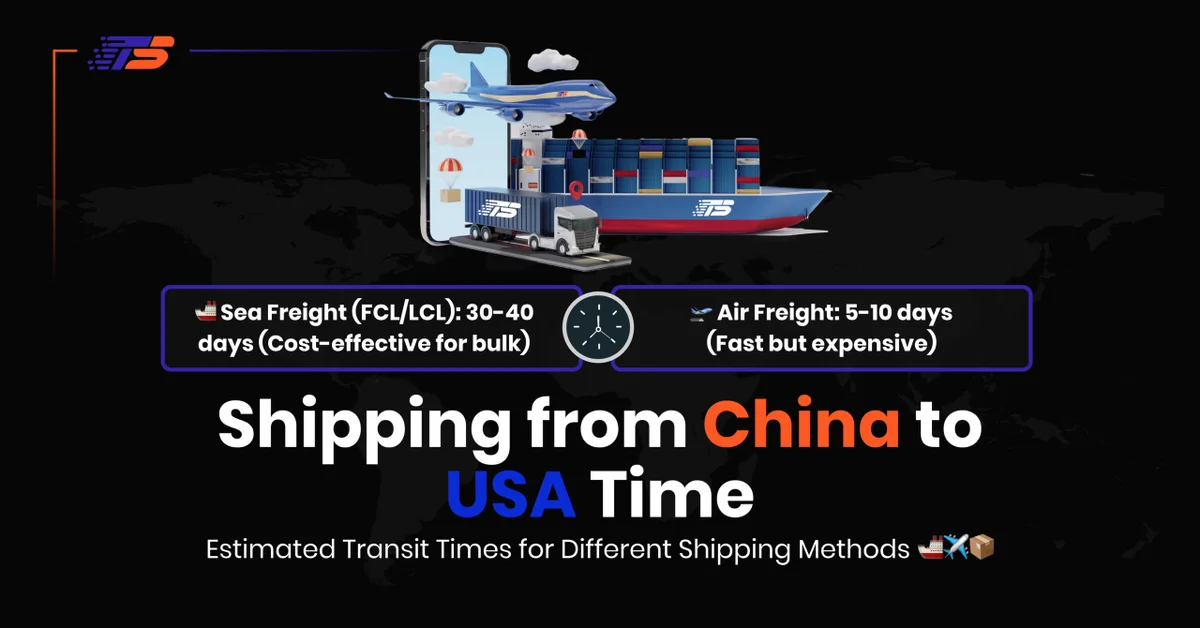
See the estimated transit times from major Chinese ports to key US destinations, plan your shipment with confidence.
| From → To | Long Beach & LA | Seattle | Houston | Chicago | Newark (NY/NJ) | Savannah |
|---|---|---|---|---|---|---|
| Shanghai (CNSHA Port) | 15-25 days | 20-25 days | 30-40 days | 35-45 days | 30-40 days | 30-40 days |
| Ningbo (CNNGB Port) | 15-25 days | 20-25 days | 30-40 days | 35-45 days | 30-40 days | 30-40 days |
| Shenzhen (CNSZX Port) | 15-25 days | 20-25 days | 30-40 days | 35-45 days | 30-40 days | 30-40 days |
Factors Affecting China-US Shipping Time
China to US shipping time isn’t fixed. Seasonal demand, customs processing, shipping method, and port congestion can all speed up or slow down delivery. Knowing these factors helps you plan smarter, avoid delays, and keep shipments on schedule. Check out the key factors below:
- Seasonal & Peak Delays: Chinese New Year, US holidays, and typhoon season can slow shipments. Add 2-3 buffer days.
- Customs Clearance: Accurate paperwork and duties are crucial. We handle customs for smooth delivery.
- Shipping Method: Choose Express, Air, Ocean, or Rail based on urgency and cost. Pick faster methods for critical shipments
- Port Congestion: Busy ports or labor strikes may cause delays. Track port status to stay ahead.
- Package Size & Volume: Large or consolidated shipments take longer. Consolidate to save cost and time.
- Unexpected Events: Natural disasters or regulatory changes can disrupt transit. Always include 2-3 buffer days in planning.
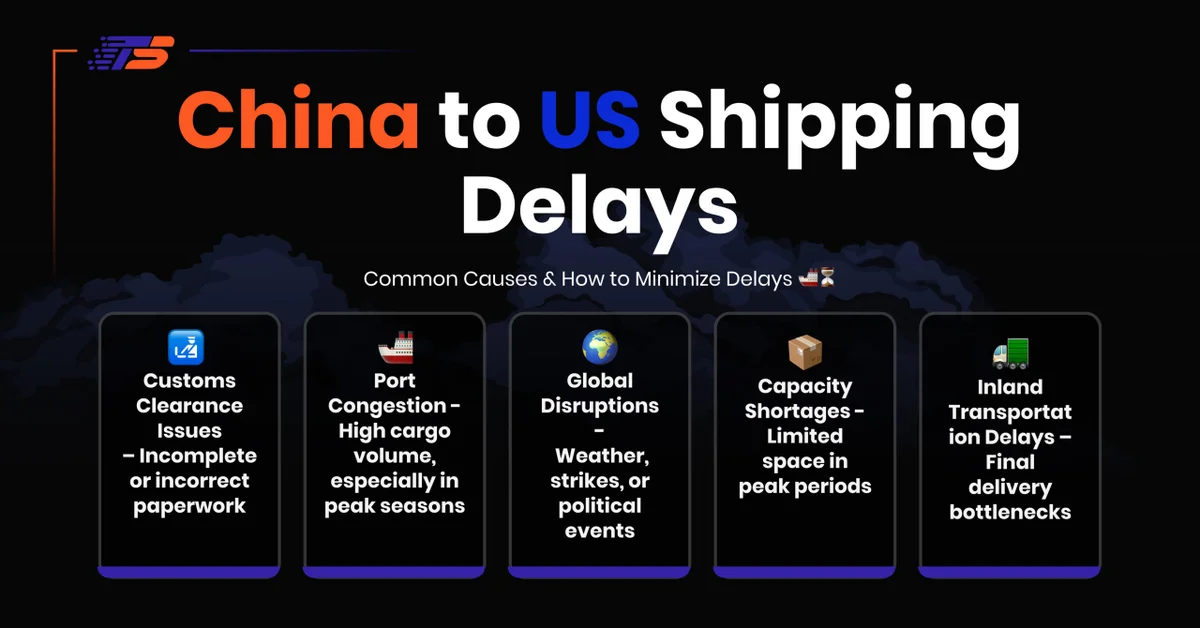
Detailed Guide to Shipping Costs from China to US
Shipping from China to the USA involves trade-offs between speed, volume, and cost. At TopShipping, we provide detailed shipping rates per kg, including duties, customs fees, and handling charges. This allows importers to have a clear picture to budget accurately, avoid hidden expenses, and choose the shipping method that best fits their timeline and cargo size.
| Service Type | Cost Range | Minimum Charge | Best For | Estimated Transit Time (Door-to-Door) |
| Express Courier (DHL/UPS/FedEx) | $8 – $15 per kg | $25 – $50 | Urgent parcels, samples, documents, eCommerce orders | 2 – 5 days |
| Air Freight (Standard) | $5 – $8 per kg | $100 – $200 | Medium-weight shipments, moderate urgency | 5 – 10 days |
| Ocean Freight (LCL) | $40 – $80 per CBM | 1 CBM minimum | Small to medium shipments (not full container) | 18 – 32 days |
| Ocean Freight (FCL) – 20ft | $1,800 – $3,000 | Full container | Bulk shipments, exclusive container use | 15 – 28 days |
| Ocean Freight (FCL) – 40ft | $2,500 – $4,200 | Full container | Large-volume cargo at optimal cost | 15 – 28 days |
| Door-to-Door Service | $12 – $20 per kg | $150 – $300 | Complete logistics solution, hassle-free shipping | 8 – 15 days |
| Amazon FBA Shipping | $3 – $6 per kg | $200 – $500 | E-commerce sellers, direct to Amazon warehouses | 12 – 25 days |
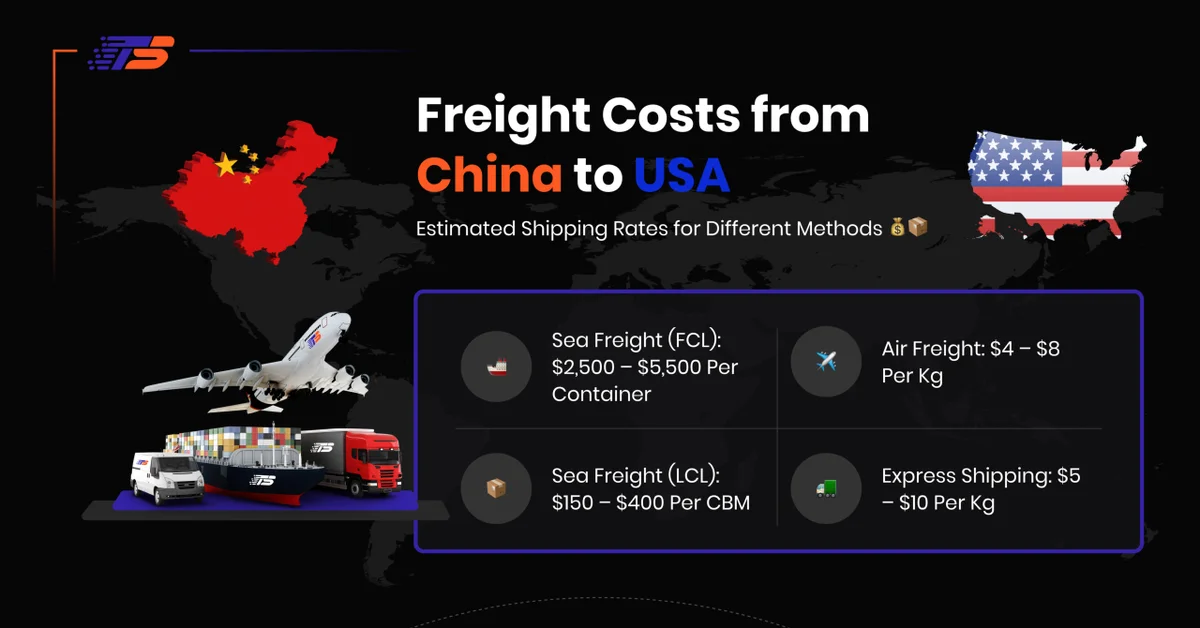
The table below shows the estimated shipping rates from major Chinese ports to key US destinations, helping you plan your costs for ocean freight.
| From → To | Long Beach & LA | Seattle | Houston | Chicago | Newark (NY/NJ) | Savannah |
|---|---|---|---|---|---|---|
| Shanghai | $1,200–$1,450 | $1,200–$1,450 | $1,800–$2,500 | $2,900–$3,800 | $1,600–$2,300 | $1,600–$2,300 |
| Ningbo | $1,200–$1,450 | $1,200–$1,450 | $1,800–$2,500 | $2,900–$3,800 | $1,600–$2,300 | $1,600–$2,300 |
| Shenzhen | $1,100–$1,400 | $1,100–$1,400 | $2,000–$2,800 | $2,900–$3,800 | $1,600–$2,300 | $1,600–$2,300 |
Shipping Cost Example: Small e-commerce shipment of 100 kg electronics from Shenzhen to Los Angeles via air freight
- Total cost: $650 (including customs)
- Transit time: 7 days
Use our CBM Calculator to estimate costs for different shipment sizes and volumes.
Factors Affecting China-USA Shipping Costs
Shipping rates change due to multiple factors. Understanding them helps you select the most cost-effective China-to-US shipping solution for your business:
- Fuel Surcharges: Costs change with global oil prices
- Peak Season: Rates increase from September to November
- Cargo Type: Hazardous, oversized, or fragile items cost more
- Origin & Destination: Prices vary between major ports and remote locations
- Volume vs. Weight: Dimensional weight pricing may apply
Top China to US Shipping Routes
Strategic port selection directly impacts shipping from china to us time, cost, and logistics efficiency. This overview covers major routes and port capabilities to help you choose the optimal path for your China-USA shipments.
Major Departure Ports in China
- Shanghai (SHACN): Largest port, handles ~40% of China’s container traffic
- Shenzhen/Yantian (SZXCN): Key hub for electronics and consumer goods
- Guangzhou (CANCN): Pearl River Delta manufacturing and trading center
- Ningbo (NGBCN): Cost-effective alternative to Shanghai
- Qingdao (TAOCN): Strategic gateway for northern manufacturers
Primary Arrival Ports in the USA
- Los Angeles/Long Beach (LAXUS): West Coast leader with strong inland rail (12-16 days)
- New York/Newark (NYKCUS): East Coast gateway to Northeast markets (18-22 days)
- Seattle/Tacoma (SEAUS): Pacific Northwest hub with Canada links (16-19 days)
- Oakland (OKDUS): Northern California alternative to LA/Long Beach (16-18 days)
- Norfolk (ORFUS): Less congested East Coast option (18-20 days)
Efficient Route Combinations
- Shanghai to Los Angeles: Frequent and ideal for bulk (14-16 days)
- Shenzhen to Los Angeles: Fast electronics corridor (15-18 days)
- Shanghai to New York: Premium East Coast delivery (20-22 days)
- Air Freight from China to US: Flexible and speedy option for urgent cargo
AI-Optimized Freight Routing
Our system uses artificial intelligence to analyze multiple shipping routes and carriers in real-time. This allows us to choose the most cost-effective and time-efficient path for each shipment. The result is reduced transportation costs, fewer delays, and improved delivery predictability for your supply chain.
Air Freight Hubs
- China: Shanghai Pudong (PVG), Guangzhou Baiyun (CAN), Shenzhen Bao’an (SZX)
- USA: Los Angeles (LAX), Chicago O’Hare (ORD), New York JFK (JFK)
China-US Shipping: Customs, Duties & Insurance
Navigating US customs regulations is crucial for successful shipping from China to US. Our specialists manage every step of customs to eliminate delays, unexpected charges, and compliance risks, so your shipments clear with confidence.
US Customs & Import Duties
US imports from China require proper documentation including commercial invoice, packing list, and product certificates. Import duties vary by product type, with many items facing 0-25% rates based on classification. Shipments under $800 typically enter duty-free, while larger commercial shipments need formal customs processing. Use our import duty calculator to estimate costs before shipping and avoid surprises at customs.
Customs Consulting Services
Navigating US customs can be complex and costly if mishandled. TopShipping provides specialized customs consulting, ensuring all documents, duties, and tariffs are handled correctly. We help importers avoid delays, penalties, and unexpected charges by guiding them through compliance with US trade regulations.
Cargo Insurance Protection
Standard marine insurance covers 110% of invoice value against loss, damage, or theft during China-US transit. Premium insurance options provide extended coverage including delays, contamination, and special handling for electronics or fragile goods. Insurance costs typically range 0.2-0.5% of cargo value – a small price compared to potential losses. Most freight forwarders offer instant coverage, but always verify policy terms before shipping high-value merchandise.
HS Codes for China–US Shipping
HS Code (Harmonized System Code) is a universal classification system for goods used in international trade. Every product shipped from China to the US must have a correct HS Code on customs documents. Using the right code ensures:
- Accurate calculation of duties and tariffs
- Smooth customs clearance without delays
- Proper insurance coverage and trade compliance
TopShipping assists importers in identifying the correct HS Code for their products, helping businesses avoid costly mistakes and shipment delays.
Incoterms & Delivery Options China Shipping To US
Incoterms define who is responsible for each stage of the China to USA shipping, from pickup in China to final delivery in the USA. Choosing the right Incoterm ensures smoother shipments and better alignment with your business needs.
| Incoterm | Seller’s Responsibility | Buyer’s Responsibility | Best For / Notes | Approx. Transit Time (China → US Ports) | Estimated Cost Responsibility |
| EXW (Ex Works) | Product ready at factory | Everything from pickup to delivery | Experienced importers with logistics expertise | 15-35 days (buyer arranges) | Seller: 5-10% / Buyer: 90-95% |
| FOB (Free On Board) | Export clearance + loading on vessel | Sea freight, insurance, import duties, inland transport | Most common for China imports, balanced risk | 15-25 days (West) / 25-35 days (East) | Seller: 15-25% / Buyer: 75-85% |
| CIF (Cost, Insurance, Freight) | Export + sea freight + marine insurance | Import duties, customs clearance, inland transport | Supplier pays freight and insurance costs | 15-25 days (West) / 25-35 days (East) | Seller: 60-70% / Buyer: 30-40% |
| DAP (Delivered At Place) | All costs except import duties | Import duties, taxes, customs clearance | Good middle ground, seller handles logistics | 18-30 days (includes inland) | Seller: 70-80% / Buyer: 20-30% |
| DDP (Delivered Duty Paid) | Everything including import duties and taxes to final destination | Only unloading goods at destination | Preferred by Amazon sellers, hassle-free | 12-25 days (door-to-door) | Seller: 90-100% / Buyer: 0-10% |
DDP vs DDU: Best Shipping Terms for China to US
Selecting between DDP and DDU directly affects your costs, responsibilities, and delivery timeline.
- Use DDP if you want a hassle-free process, predictable costs, or limited customs expertise. Suppliers with established US operations can offer competitive DDP rates and faster clearance through their brokers.
- Use DDU if you have reliable customs support, prefer control over the import process, or can optimize duty costs independently. Experienced US importers often choose DDU to maintain direct relationships with customs and potentially reduce overall expenses.
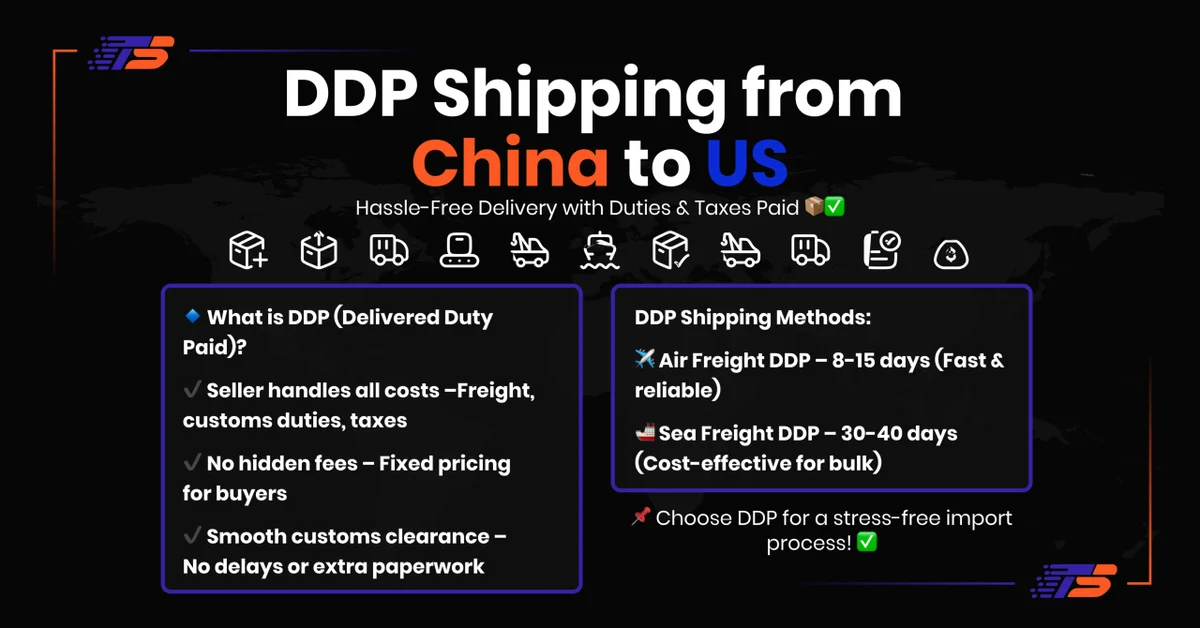
Top Freight Forwarders for China-US Shipping
Access to top international freight forwarders gives importers a competitive edge. We partner with leading carriers including DHL, FedEx, and UPS for express delivery, plus major airlines and ocean lines for air and sea freight. This broad carrier network drives down costs, ensures predictable transit times, and provides end-to-end visibility across all shipping modes.
Picking the Right Freight Forwarder
A reliable forwarder reduces delays, avoids hidden costs, and ensures smooth China-to-US shipments. Focus on these key factors:
- Experience & China-US Expertise: Proven knowledge of ports, customs, and peak-season challenges.
- Carrier Network & Flexibility: Access to multiple shipping modes and competitive rates.
- Customs & Compliance: Handles documentation, duties, and HS codes efficiently.
- Transparent Pricing: Clear quotes covering freight, surcharges, and delivery costs.
- Tracking & Support: Real-time visibility and responsive customer service.
- Scalability: Ability to support growing shipments and value-added services.
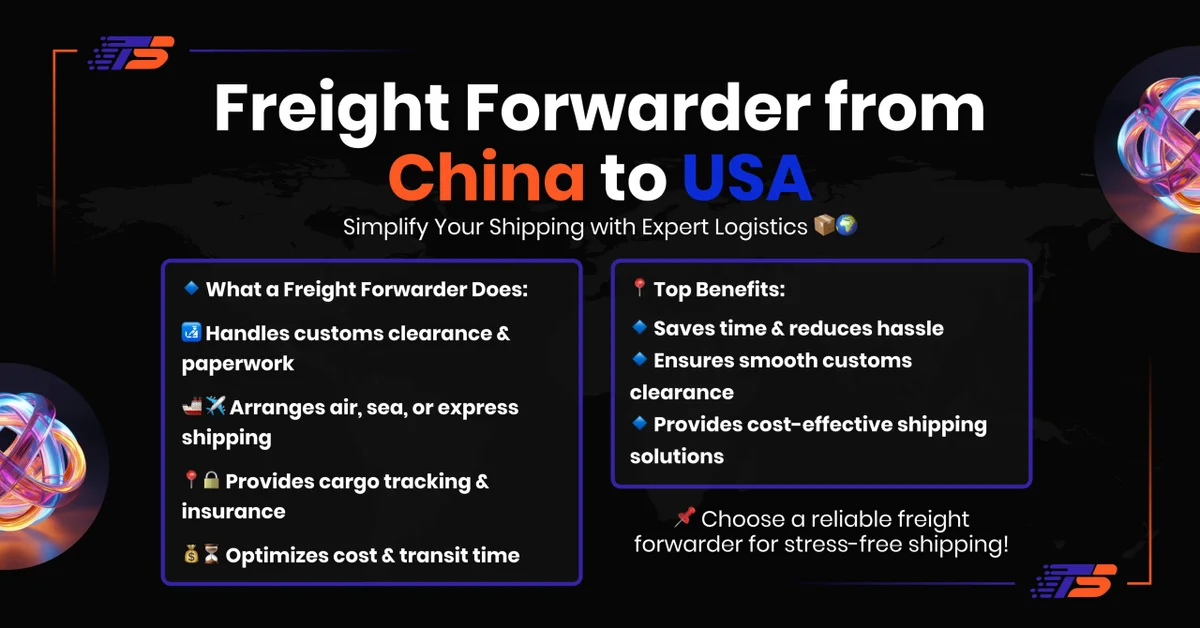
Supplier Sourcing Support in China
Finding a reliable supplier in China is critical for long-term success. TopShipping assists importers with supplier vetting, quality control, and sourcing support, ensuring your supply chain remains stable and your products meet required standards. This reduces risks and builds a foundation for sustainable growth.
Track Your China-US Shipments in Real Time
Importers need certainty at every stage of the supply chain. With real-time shipment visibility, you gain complete cargo monitoring into your shipment’s journey, knowing exactly where your goods are and when they’ll arrive. below are some of the tracking features:
- Multi-Carrier Tracking: One tracking number for DHL, FedEx, UPS, air, and ocean shipments with real-time status updates.
- Customer Notifications: Automated customer notifications keep buyers informed at every step of the shipping journey.
- End-to-End Milestones: Monitor pickup in China, export customs, in-transit updates, U.S. customs clearance, and final delivery.
- Flexible Access: Track online, via mobile app, email, SMS, or API for seamless business integration.
- Enhanced Visibility: Real-time ETAs, customs status, delivery scheduling, and optional photo confirmation at delivery.
Service-Based Tracking
- Express: GPS-level tracking with frequent updates
- Air Freight: Flight schedules, airport handling, and transit updates
- Ocean Freight: Vessel location, port notifications, and ETAs
- Amazon FBA: Direct updates to your Amazon seller dashboard for smooth FBA prep
Additional Considerations for China-US Shipping
Some shipments need extra care for compliant cross-border logistics. Key considerations for China-USA shipping:
- Sensitive Cargo: Electronics, fragile, high-value, or hazardous goods. Use proper packaging, climate control, and insurance. Prefer express or air for urgent shipments.
- Restricted Items: Certain food, cosmetics, medical devices, electronics, and textiles need permits; prohibited items cannot be shipped. Always confirm compliance.
- Peak Seasons: Holidays and peak months (Sep-Nov) may delay shipments. Book early and consider alternative routes.
- Bulk & High-Volume: Consolidate shipments to save costs; dedicated space and warehouse support improve efficiency.
- 3PL & Fulfillment: Use third-party logistics providers for inventory management, multi-channel distribution, and last-mile delivery across the US without maintaining your own warehouse facilities.
Pro Tips:
- Declare accurate product details and values
- Consult experts for restricted shipments
- Plan longer lead times during busy seasons
- Use express or air freight for time-sensitive cargo
Final Guide: China-US Shipping Options
Successful shipping from China to US depends on balancing speed, cost, and reliability. Express shipping is best for urgent, high-value goods; air freight provides a strong balance between transit time and pricing; and ocean freight remains the most economical option for large-volume imports despite longer transit times.
Equally important are the supporting factors, accurate documentation, smooth customs clearance, trusted shipping partners, and smart planning for peak seasons. Whether you’re sending electronics via express, consolidating mid-sized loads through air freight, or importing bulk orders by sea, the key is aligning your shipping method with your business priorities. By focusing on compliance, efficiency, and cost control, importers can ensure smooth and predictable China-USA logistics.
FAQs: Shipping from China to US
How much does it cost to ship from China to USA?
Costs depend on shipping method and volume. Express ranges $8-15/kg, air freight $4-8/kg, and sea freight $800-2,500 per container or $50-150/CBM for LCL. Get an instant quote for accurate pricing tailored to your shipment.
How long does shipping from China to USA take?
Transit times vary: Express 1-5 days, Air Freight 3-7 days, Sea Freight 15-25 days. Customs clearance may add 1-3 days depending on cargo type and documentation.
What is the cheapest way to ship from China to USA?
Sea freight is the most cost-effective, especially for large shipments. LCL suits smaller volumes; FCL is best for bulk orders. Consolidated air freight offers value for urgent, lightweight items.
Why is shipping from China to USA so affordable?
High export volumes, advanced port infrastructure, and extensive shipping capacity lower costs. Recent price increases are due to fuel fluctuations and capacity constraints.
What documents are required for importing from China to USA?
Essential documents include: commercial invoice, packing list, bill of lading, and certificate of origin. Some products may require permits, FDA approvals, or safety certifications.
How much is DHL from China to USA?
DHL typically charges $8-15/kg depending on weight, size, and destination. Rates vary by service type, delivery location, and peak season. Volume discounts are available for regular shipments.
Can I ship directly to Amazon FBA warehouses?
Yes. Door-to-door FBA shipping includes customs clearance, labeling, and appointment scheduling. DDP service ensures smooth delivery and compliance with Amazon standards.
What’s the difference between FCL and LCL shipping?
FCL (Full Container Load): Rent an entire container, ideal for large shipments. A: LCL (Less than Container Load): Share container space with other importers, best for smaller volumes.
Do I need to pay customs duties when importing from China?
Yes, most imports are subject to US customs duties and taxes. Rates depend on product classification (HS code). Additional costs may include customs clearance fees, broker charges, and inspection fees.
How can I track my shipment from China to USA?
Real-time tracking is available via online portal, mobile app, email, or SMS. Monitor every milestone—from pickup in China to final delivery in the USA.
What is the Best Way to Ship from China to US?
When supply chain challenges arise, you need expertise and reliable solutions, not just cheap quotes. The most effective approach for China-US shipping is working with a trusted Chinese freight forwarder, regardless of your chosen method. These specialists offer several key advantages, ensuring smooth operations and protecting your business from unexpected disruptions
When should I use air freight from China?
Use air freight for time-sensitive shipments, high-value lightweight goods, seasonal products with tight deadlines, sample orders, and emergency restocking. If delivery speed directly impacts your sales or the item’s value justifies higher shipping costs, choose air freight over slower sea options.
Why Air Freight is cheaper than Sea Freight?
Air freight can be more cost-effective for lightweight, high-value items where sea freight minimum charges exceed air rates. It also eliminates 3-4 weeks of inventory holding costs, reduces working capital tie-up, and enables faster cash flow from quicker sales – often making the total landed cost lower than sea freight.

